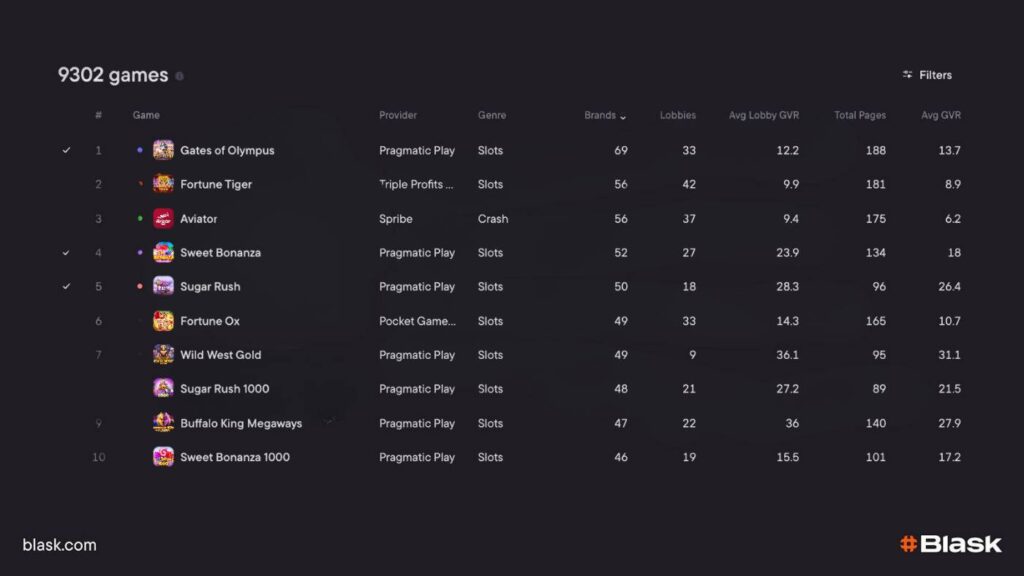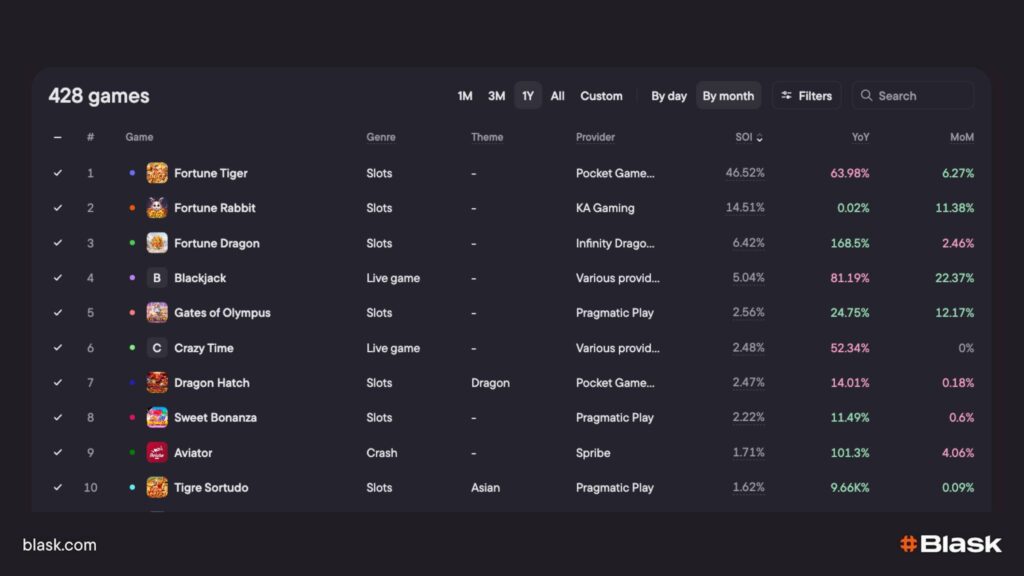Lobby CTR
What lobby CTR is
Lobby click-through rate is the simplest way to ask whether your storefront works — how many players who see a game tile actually enter it.
Formally, it’s clicks on a game card divided by qualified lobby impressions for that card over a period. Qualified impressions exclude tiles that never came into view, auto-rotations that flashed for a fraction of a second, and duplicate views from the same session.
🚀 In practice, lobby CTR is your first conversion: from shelf to game.
- The number is sensitive to context. Above-the-fold tiles earn attention by default; row-three tiles must be chosen.
- Copy matters: “buy feature available” or “jackpot live now” can lift CTR without touching mechanics.
- Art direction matters more than most teams admit — recognisable IP, legible symbols at phone size, and a dominant colour that stands out against the shelf.
- Timing matters, too. A festival skin promoted two weeks early will underperform; the same skin, raised three days before the event, can double CTR with no code change.
Measurement should be honest.
Count an impression only when 50–60% of the tile is on screen for, say, 700–900 ms. De-dupe within a session.
Track qualified CTR — clicks that lead to at least one spin within 30 seconds — alongside raw CTR, so you can tell curiosity from intent. Keep device and country cuts separate; mobile thumbs and desktop mice read layouts differently.
🚀 The lobby is your front page
Think like an editor. Headlines above the fold, clear subheads on row two, and no mystery meat navigation.
How teams actually use lobby CTR
- Operators treat CTR as the first health check on merchandising. If a top-row card underperforms, fix the headline before the mechanics: rewrite the tile line in plain language, test a badge (“new”, “tournament”, “buy feature”), switch to art that reads at a glance, and reconsider position.
Map position curves (using GVR) — average CTR by row and slot — so you can judge whether a card is weak or simply in a weak seat. Then tie CTR to downstream metrics: first-minute bounce, time to first spin, and day-7 return. A card that clicks well but bounces fast is selling a promise the game can’t keep.
Providers read CTR as leverage. If a title earns above-benchmark CTR wherever it gets a fair seat, that’s an argument for a better one.
If CTR collapses only with one operator’s skin or copy, it’s a creative issue, not a product one. Studios that ship clean, phone-first logos and a one-line “why click” give themselves an advantage before negotiations begin. - Affiliates influence CTR by expectation-setting. A pre-roll that shows the real tempo of a title — not a jackpot highlight reel — sends players to the lobby ready to click and stay.
That alignment between story and store is worth more than a louder CTA.
A practical playbook
- Close the loop. Judge success on CTR and first-minute bounce, time-to-first-spin, day-7 return. Keep the winners; retire the liars.
- Measure cleanly. Count an impression when ≥50–60% of the tile is on screen for ~700–900 ms; de-dupe within session; track qualified CTR (click→spin).
- Fix copy. Replace metaphors with promises a newcomer understands in one glance (“Free spins from the start,” “Buy feature available,” “Jackpot live”).
- Fix art. Use high-contrast icons, recognisable IP marks, and legible symbols at phone size; avoid busy key art.
- Test badges. “New,” “Hot,” event tags, or “Buy feature” labels often move CTR without touching mechanics.
- Move the seat. Promote from seat 6→3 for 72 hours; if CTR doubles and bounce falls, negotiate a permanent row.
- Mind the clock. Align seasonal skins with the real calendar; lift three to five days before peak.
Reading and scaling with Blask Games
CTR is a house metric, but distribution and visibility are what let it scale. This is where Blask Games complements your telemetry by showing how widely — and how prominently — a title is placed across the market.
In Games you can track for any game:
- number of brands carrying it
- number of lobbies where it appears
- Avg Lobby GVR (Game Visibility Rank) the average position within each lobby page)
- Avg GVR across all surfaced placements.

🔍 Read the Blask Games quick tour for more insights.
Read these with your CTR:
- Healthy CTR in your app but thin brands/lobbies and deep Avg Lobby GVR means a distribution problem — broaden coverage and negotiate higher seats.
- Excellent Avg Lobby GVR with weak in-house CTR points to copy/asset issues on your skin.
- Pair with Game Visibility Rank (GVR) and Share of Interest (SoI): rising SoI with flat CTR usually means the card isn’t telling the truth the audience wants.
- Use Blask Index as backdrop: when market heat rises, move proven high-CTR cards into headline seats; when it cools, rotate to evergreen clarity.

🚀 Placement scales persuasion. CTR says how the card sells. Brands, lobbies, Avg Lobby GVR and Avg GVR say where it can sell next.